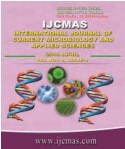


 National Academy of Agricultural Sciences (NAAS)
National Academy of Agricultural Sciences (NAAS)

|
PRINT ISSN : 2319-7692
Online ISSN : 2319-7706 Issues : 12 per year Publisher : Excellent Publishers Email : editorijcmas@gmail.com / submit@ijcmas.com Editor-in-chief: Dr.M.Prakash Index Copernicus ICV 2018: 95.39 NAAS RATING 2020: 5.38 |
Vanilla planifolia is popularly known as Prince of Spices a fleshy perennial liana grown in and around Western Ghats for its natural compounds used in several ice creams, chocolates and beverages. Fusarium oxysporum f.sp. vanillae is one of the most destructive pathogens causing severe loss to yield and during the survey conducted in 2016, maximum of 25 % incidence was noticed in coorg district. The pathogen was isolated and morphologically identified as F. oxysporum based on the conidial, chlamydosporial and cultural characters. The size of microconidia ranged between 5.97 to 8.60 µm in to 2.02 to 4.07 µm in width, most of the isolates did not produce macro conidia. Further to confirm the identity of pathogen, 18S rDNA or ITS region DNA was amplified and sequenced. A phylogenetic tree was constructed using Maximum likelihood showed clearly two distinct cluster which clearly out grouped the Colletotrichum gloeosporioides and all other Fusarium sp. in one clade. The seven isolates used in the study grouped under F. oxysporum clearly separating from other species of Fusarium. Futher Tajima’s test also showed only six nucleotide differences indicating that the pathogen is F. oxysporum f.sp. vanilla.
 |
 |
 |
 |
 |